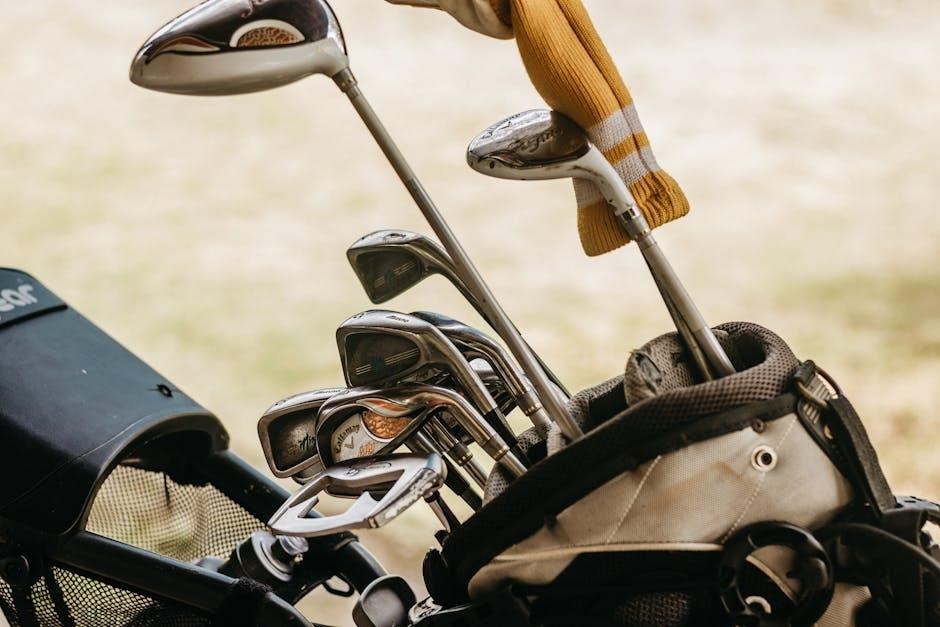OEM golf shaft replacement involves swapping out the original shaft in your club with a new one‚ ensuring optimal performance and consistency. This guide covers everything from understanding shaft specifications to installation tips‚ helping golfers improve their game through precise customization and maintenance. Whether you’re addressing damage or upgrading‚ this resource provides a clear path to achieving the best results.
1.1 What is an OEM Golf Shaft?
An OEM (Original Equipment Manufacturer) golf shaft is the original shaft fitted into a golf club during its production. It is designed to meet the specific specifications of the clubhead‚ ensuring optimal performance and consistency. Each OEM shaft is tailored to match the club’s weight‚ flex‚ and torque requirements‚ enhancing the golfer’s swing dynamics. Unlike aftermarket options‚ OEM shafts are precisely engineered for their respective club models‚ maintaining the manufacturer’s intended performance characteristics. This makes them a preferred choice for golfers seeking authenticity and reliability in their equipment.
1.2 Why Replace an OEM Shaft?
Replacing an OEM shaft is often necessary due to damage‚ wear‚ or the desire to enhance performance. Over time‚ shafts can degrade‚ affecting accuracy and distance. Upgrading to a new shaft can restore or improve your club’s feel and consistency‚ while addressing specific swing characteristics. Additionally‚ modern shafts may offer advanced materials and technologies that the original OEM shaft lacks‚ providing better torque‚ flex‚ and weight distribution. Whether repairing damage or optimizing performance‚ replacing the shaft ensures your club continues to meet your evolving needs on the course.
1.3 Benefits of OEM Shaft Replacement
Replacing an OEM shaft offers numerous benefits‚ including improved performance‚ enhanced customization‚ and the ability to tailor your club to your unique swing characteristics. A new shaft can restore or even elevate the feel and consistency of your club‚ addressing issues like flex‚ weight‚ and torque. Additionally‚ it allows you to leverage advancements in materials and technology that may not have been available when the original shaft was manufactured. By upgrading‚ you can achieve better accuracy‚ distance‚ and overall control‚ ensuring your equipment aligns with your evolving skills and playing style for optimal results on the course.

Choosing the Right Replacement Shaft
Choosing the right replacement shaft involves considering factors like flex‚ torque‚ and weight to match your swing characteristics. OEM shafts ensure compatibility and performance‚ while new materials can enhance play.
2.1 Understanding Shaft Flex and Its Importance
Shaft flex refers to how much a shaft bends during a golf swing‚ directly impacting accuracy and distance. Proper flex aligns with swing speed: slower swings need more flexible shafts‚ while faster swings require stiffer ones. Common flex categories include Ladies‚ Senior‚ Regular‚ Stiff‚ and Extra Stiff. Choosing the wrong flex can lead to inconsistent shots‚ as the shaft may not load or unload correctly. Understanding your swing dynamics is crucial for selecting the right flex‚ ensuring optimal performance and consistency in your game. This step is vital for a successful OEM shaft replacement.
2.2 Selecting the Correct Shaft Length
Choosing the correct shaft length is vital for maintaining proper swing mechanics and maximizing performance. Shafts that are too long or too short can disrupt your posture‚ balance‚ and consistency. Factors such as your height‚ stance‚ and swing type influence the ideal length. Standard shaft lengths vary by club type‚ with drivers typically longer than irons. Many modern shafts offer adjustable options‚ allowing for precise customization. Measuring your current setup and consulting OEM guidelines or a professional fitter ensures the best fit. Incorrect shaft length can lead to poor ball striking and discomfort during your swing.
2.3 Material Options: Steel vs. Graphite Shafts
When replacing an OEM shaft‚ choosing between steel and graphite is crucial. Steel shafts are known for their durability and consistent feel‚ making them ideal for players seeking precise control and accuracy. Graphite shafts‚ lighter and more flexible‚ reduce vibration and increase swing speed‚ benefiting those with slower tempos or seeking added distance. Each material caters to different swing styles and preferences. Steel is better for stronger players‚ while graphite suits those prioritizing comfort and performance. Advanced options like multi-material shafts combine the best of both worlds‚ offering a tailored experience for unique needs. Consider your game goals and physical characteristics when deciding.
2.4 Considering Torque and Kick Point
Torque and kick point are critical factors in selecting the right replacement shaft. Torque measures how much the shaft twists during the swing‚ impacting accuracy and consistency. A lower torque shaft is ideal for stronger players with faster swing speeds‚ while higher torque suits those with slower tempos. The kick point‚ where the shaft begins to flex‚ affects ball trajectory. A higher kick point produces a lower shot‚ while a lower kick point results in a higher trajectory. Balancing these elements ensures optimal performance‚ aligning with your swing characteristics and desired ball flight. Proper selection enhances control and distance‚ tailored to your unique playing style.

Understanding OEM Shaft Specifications
Understanding OEM shaft specifications is crucial for proper replacement. Key factors include tip size‚ shaft weight‚ flex profile‚ and MPF codes‚ ensuring compatibility and optimal performance.
3.1 Decoding Shaft Tip Size and Hosel Diameter
Shaft tip size and hosel diameter are critical for compatibility. The tip size refers to the shaft’s end diameter‚ while the hosel diameter is the clubhead’s internal opening. Mismatching these can cause improper seating or damage. Manufacturers design clubs with specific measurements‚ so replacing a shaft requires precise alignment. Measure both tip and hosel accurately using a caliper for a secure fit. Check OEM specifications or guides to ensure compatibility‚ preventing issues like loose connections or shaft damage. Proper alignment ensures optimal performance and durability‚ making this step essential for a successful replacement. Always refer to manufacturer guidelines for accurate measurements.
3.2 Importance of Shaft Weight and Balance
Shaft weight and balance are vital for optimal club performance. A shaft that is too light or heavy can alter swing dynamics‚ affecting accuracy and distance. Proper balance ensures the clubhead moves consistently‚ improving control and reducing fatigue. OEM shafts are designed to match specific clubhead weights‚ maintaining intended performance. Replacing with a shaft of incorrect weight can disrupt this balance‚ leading to poor results. Always consult OEM guides to select a shaft that aligns with the original specifications‚ ensuring seamless integration and maintaining the club’s designed feel and functionality for consistent play.
3.3 Role of Shaft Flex Profiles in Performance
Shaft flex profiles play a crucial role in determining club performance. Flex refers to how much a shaft bends during a swing‚ influencing ball flight and feel. Proper flex alignment with a golfer’s swing speed and style ensures consistent distance and accuracy. Incorrect flex can lead to misalignment‚ poor vibration‚ and reduced energy transfer to the ball. OEM shafts are designed with specific flex profiles to match clubhead dynamics‚ optimizing performance. Understanding and selecting the right flex is essential for maximizing potential and achieving a smoother‚ more controlled swing‚ making it a key factor in shaft replacement decisions.
3.4 MPF Codes and Their Significance
MPF (Moment of Inertia) codes are critical in shaft selection‚ as they represent a standardized rating system for shaft performance. Developed by Golf Digest‚ these codes help golfers and fitters compare shafts based on their flex‚ weight‚ and torque. Each code corresponds to specific swing characteristics‚ ensuring the right match for a golfer’s style. MPF codes simplify the process of finding compatible replacements‚ maintaining consistency in feel and performance. They are essential for achieving optimal results during OEM shaft replacement‚ ensuring the new shaft aligns with the club’s design and the golfer’s needs.

Preparing for Shaft Replacement
Ensure you have the right tools‚ like a heat gun and epoxy‚ and a clean workspace. Follow safety guidelines to avoid damage and ensure a smooth process.
4.1 Tools and Equipment Needed
To replace a golf shaft‚ you’ll need a heat gun for removing old epoxy‚ a vice to secure the club‚ and a shaft removal tool for safe extraction. Additional items include epoxy resin‚ a mixing stick‚ and cleaning solvents for preparing the hosel. A torque wrench ensures proper clubhead reattachment‚ while a shaft alignment tool helps maintain accuracy. Protective gloves and safety goggles are essential for safeguarding against heat and debris. Optional items like a shaft weight scale or a hosel reamer can further enhance precision. Having all tools ready ensures a smooth and efficient replacement process.
4.2 Safety Precautions and Best Practices
When replacing a golf shaft‚ prioritize safety to avoid injury and ensure a successful process. Always wear protective gear‚ including safety goggles and gloves‚ to shield yourself from debris and heat. Use a heat gun cautiously to prevent burns‚ and maintain a well-ventilated workspace to avoid inhaling epoxy fumes. Secure the club in a vice to prevent movement during shaft removal or installation. Follow manufacturer guidelines for tools and materials to minimize risks. Work in a well-lit area for clear visibility‚ and keep flammable materials away from heat sources. Proper preparation and adherence to these practices will help ensure a smooth and safe replacement.
4.3 Setting Up Your Workspace
Setting up a well-organized workspace is crucial for a successful OEM shaft replacement. Begin by clearing a sturdy‚ flat surface and covering it with a heat-resistant material to protect against epoxy spills or heat damage. Secure the golf club in a vice to ensure stability during the process. Gather all necessary tools‚ such as a heat gun‚ epoxy‚ and shaft puller‚ and keep them within easy reach. Proper lighting is essential‚ so position a lamp to illuminate your work area. Lastly‚ ensure good ventilation to avoid inhaling epoxy fumes. A clean‚ stable workspace will help you stay focused and efficient throughout the replacement process.

Removing the Old Shaft
Removing the old shaft involves using a heat gun and shaft puller to safely detach it from the clubhead‚ ensuring no damage to the hosel; stubborn shafts may require additional techniques.
5.1 How to Safely Remove the Shaft from the Clubhead
To safely remove the old shaft‚ apply heat to the epoxy bond using a heat gun for several minutes. Once loosened‚ use a shaft puller to gently extract the shaft from the clubhead. Protect the clubhead with a towel to prevent damage. Avoid excessive force‚ as it may harm the hosel. For stubborn shafts‚ apply additional heat or use a solvent to break down the adhesive. Always work in a well-ventilated area and follow safety guidelines to ensure a successful removal without damaging the club.
5.2 Tips for Removing Stubborn or Stuck Shafts
For stubborn shafts‚ apply additional heat using a heat gun and let it penetrate the epoxy bond. Gently rock the shaft back and forth while pulling to avoid breaking it. If still stuck‚ apply a small amount of solvent like acetone to the bond area. Use a vise to secure the clubhead and carefully twist the shaft while pulling upward. Avoid using excessive force‚ which could damage the club. For severely stuck shafts‚ consider using a shaft puller with extra grip. Always wear gloves and work in a well-ventilated space for safety.

5.3 Cleaning the Hosel and Preparing for Installation
After removing the old shaft‚ thoroughly clean the hosel to ensure a proper bond with the new shaft. Use a heat gun to soften any remaining epoxy residue. Scrape out debris with a hosel reamer or a small‚ flat tool. Wipe the area with acetone to remove grease and dirt. Inspect the hosel for any damage or old adhesive and address it before proceeding. Once clean and dry‚ lightly roughen the surface with sandpaper to enhance epoxy adhesion. Allow the area to cool and air dry completely before installing the new shaft. Proper preparation ensures a secure and lasting bond.

Installing the New Shaft
Installing a new shaft requires precise alignment and proper epoxy application to ensure a secure‚ lasting bond. Follow manufacturer guidelines for curing times and techniques.
6.1 Aligning the Shaft Properly
Proper alignment of the new shaft is critical for optimal performance. Begin by ensuring the shaft is correctly seated in the hosel‚ aligning the clubface and shaft spine. Use a heat gun to soften any epoxy residue‚ allowing precise positioning. Double-check the shaft’s orientation with the clubhead’s design specifications. Misalignment can lead to inconsistent performance and reduced accuracy. Once aligned‚ secure the shaft firmly to prevent movement during curing. Proper alignment ensures a consistent swing weight and balance‚ directly impacting the club’s overall performance and your gameplay experience.
6.2 Applying Epoxy and Ensuring a Secure Fit
Applying epoxy is a critical step in securing the new shaft. Begin by cleaning the hosel and shaft tip with isopropyl alcohol to ensure a clean bond. Mix the epoxy according to the manufacturer’s instructions‚ ensuring thorough mixing for proper curing. Apply the epoxy evenly around the shaft tip‚ avoiding air bubbles. Carefully insert the shaft into the clubhead‚ maintaining proper alignment. Secure the shaft with clamps or tape to prevent movement during curing. Allow the epoxy to cure for the recommended time‚ ensuring a strong bond. After curing‚ inspect the joint for stability and security.
6.4 Curing and Inspection
After applying epoxy‚ allow the shaft to cure in a stable environment for the recommended time‚ typically 24-48 hours. Avoid disturbing the club during this period to ensure a strong bond; Once cured‚ inspect the shaft and hosel for any gaps or air bubbles in the epoxy. Check the shaft’s alignment and ensure it is securely fitted. Lightly twist the shaft to confirm stability and integrity. If any issues are found‚ reapply epoxy as needed. Proper curing and inspection are critical for a reliable and durable connection‚ ensuring optimal performance and longevity of the shaft and clubhead.

Re-Gripping the Club
Re-gripping your club is essential after shaft replacement to ensure a secure and comfortable hold. This process involves selecting the right grip size and material‚ then installing it properly to align with the shaft and clubhead for consistent performance and control.
7;1 Selecting the Right Grip for Your Shaft
Selecting the right grip for your shaft is crucial for comfort and performance. Grips come in various sizes‚ materials‚ and textures‚ catering to different hand sizes and swing styles. Standard‚ midsize‚ and oversized grips are common options‚ while materials like rubber‚ cord‚ or hybrid offer varying levels of durability and tackiness. Consider your swing speed‚ grip pressure‚ and personal preference when choosing. A well-fitted grip ensures consistent control and reduces fatigue‚ making it an essential step in the re-gripping process to enhance your overall golfing experience.
7.2 How to Install a New Grip
Installing a new grip requires careful preparation and precision. Start by cleaning and drying the shaft to ensure proper adhesion. Apply a thin‚ even layer of grip solvent or tape to the shaft‚ then slide the grip into place. Align the grip carefully‚ ensuring it is straight and evenly positioned. Use a rubber vise or clamp to hold it securely while the adhesive sets. Allow the solvent to dry completely before testing the grip. Proper installation ensures a secure‚ comfortable fit‚ enhancing your swing consistency and overall performance on the course.
7.3 Ensuring Proper Alignment and Fit
Proper alignment and fit are crucial for optimal performance. After installing the grip‚ inspect it visually to ensure it is straight and evenly positioned. Use a double-sided tape or solvent to secure it firmly. Avoid twisting the grip during installation‚ as this can lead to misalignment. Once set‚ test the grip by lightly tugging and rotating the club to ensure stability. A well-aligned grip enhances control and consistency‚ providing a comfortable feel during each swing. Proper fit ensures your club performs as intended‚ maximizing your game’s potential and delivering precise shots every time.

Final Checks and Testing
Final checks ensure the shaft is securely fitted‚ the grip is aligned‚ and the club performs as expected. Testing involves swinging to confirm balance and consistency‚ making any necessary adjustments for optimal play.
8.1 Verifying Shaft Alignment and Integrity
After installation‚ confirm the shaft is perfectly aligned with the clubhead and grip. Use alignment tools or visual inspection to ensure the shaft is straight and properly seated. Check the epoxy bond for any gaps or weaknesses‚ ensuring it’s cured evenly. A misaligned or loose shaft can affect performance. Double-check the MPF code and specs match the manufacturer’s recommendations. Proper alignment ensures consistent ball flight and accuracy. Verify the shaft’s integrity by inspecting for any visible damage or defects post-installation.
8.2 Testing the Club’s Performance
After replacing the shaft‚ test the club on the course or driving range to assess its performance. Hit several balls to evaluate feel‚ consistency‚ and distance. Check if the ball flight is accurate and if spin rates match expectations. Compare the club’s performance to its pre-replacement state to ensure improvement. Pay attention to any changes in swing weight or balance. This step ensures the new shaft aligns with your swing dynamics and enhances overall gameplay. Adjustments may be needed for optimal results‚ but proper installation typically yields immediate performance gains.
8.3 Making Adjustments as Needed
After testing‚ fine-tune the club to ensure optimal performance. Check the lie‚ loft‚ and swing weight‚ making adjustments as necessary. Re-gripping or re-shimming may be required to restore balance. If the shaft feels too stiff or flexible‚ consider reamers or heat guns for precise modifications. Document the changes and refer to manufacturer guidelines for specifications. Proper adjustments ensure the club aligns with your swing mechanics‚ enhancing accuracy and distance. Tailoring the setup to your preferences guarantees a seamless transition and improved gameplay consistency.

Resources and Manufacturer Guides
Major brands provide detailed OEM shaft replacement guides‚ including MPF codes and compatibility charts. Online forums and communities offer additional support and troubleshooting tips for enthusiasts.
9.1 OEM Shaft Replacement Guides by Major Brands
Major golf manufacturers like Fujikura and Gamola Golf provide detailed OEM shaft replacement guides. These resources include MPF codes‚ hosel diameters‚ and tip sizes‚ ensuring compatibility. Brands often list stock shafts and their specifications‚ making it easier to find the right replacement. Guides may also offer recommendations for alternative shafts if the original is unavailable. By referencing these official guides‚ golfers can ensure accuracy and performance. Always verify the guide corresponding to your club’s manufacturer for the most precise information.
9.2 Where to Buy OEM Replacement Shafts
OEM replacement shafts can be purchased directly from manufacturers like Fujikura or through authorized retailers such as Golfworks. Many brands provide online catalogs with MPF codes and specifications for easy selection. Additionally‚ third-party retailers often carry a wide range of OEM shafts‚ ensuring availability. Always verify the authenticity and compatibility of the shaft with your club model before purchasing. Cross-referencing with the manufacturer’s guide ensures you buy the correct replacement‚ maintaining performance and consistency in your game.
9.3 Online Communities and Forums for Support
Online communities and forums are invaluable resources for golfers seeking guidance on OEM shaft replacement. Websites like GolfWRX and Reddit’s r/golf host extensive discussions where enthusiasts and professionals share insights‚ troubleshooting tips‚ and recommendations. These platforms allow you to connect with experienced golfers‚ ask specific questions‚ and gain firsthand advice on selecting and installing the right shaft. Additionally‚ manufacturer-hosted forums often provide official guidance and updates‚ ensuring you stay informed about the latest trends and techniques in shaft replacement. Engaging with these communities can enhance your understanding and confidence in the process.
Replacing an OEM golf shaft can significantly enhance performance and customization. With proper tools and guidance‚ golfers can confidently upgrade their equipment‚ ensuring optimal play and satisfaction.
10.1 Summary of Key Takeaways
Replacing an OEM golf shaft can significantly enhance your game by ensuring optimal performance and customization. Key considerations include understanding shaft flex‚ length‚ and material to match your swing dynamics. Proper tools and preparation are essential for safe and effective installation. Following step-by-step guides and manufacturer specifications ensures a secure fit and alignment. Regular maintenance and inspections can prevent future issues. By upgrading or replacing your shaft‚ you can achieve better accuracy‚ distance‚ and overall play consistency‚ making the effort worthwhile for golfers seeking improvement.
10.2 Encouragement to Upgrade Your Game
Upgrading your golf shaft is a powerful way to elevate your performance and enjoy the game more. By investing in the right OEM replacement‚ you can unlock better distance‚ accuracy‚ and consistency. Tailoring your equipment to your swing ensures a more enjoyable and competitive experience. Don’t hesitate to take the next step—your game deserves the best. With the insights from this guide‚ you’re equipped to make informed decisions and enhance your overall play. Upgrade your shaft‚ and discover a new level of confidence and precision on the course. Your improved game awaits!
